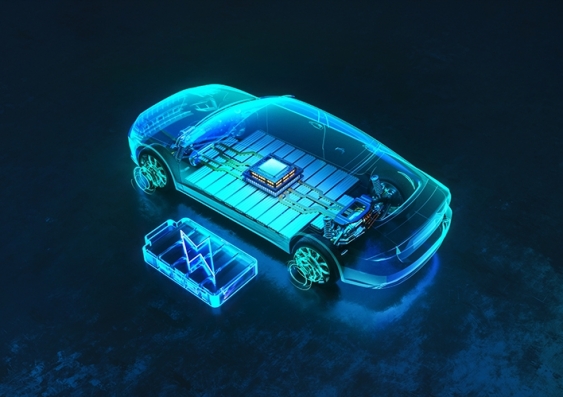Yokohama National University scientists have teamed up with researchers from the University of New South Wales (UNSW) in Australia to develop a positive electrode material for solid-state batteries that retains its volume after repeated charging cycles. The material, Li8/7Ti2/7V4/7O2, is a binary system of optimized portions of lithium titanate (Li2TiO3) and lithium vanadium dioxide (LiVO2). When ball-milled down to an appropriate particle size in the order of nanometers, it offers high capacity due to its large quantity of lithium ions that can be reversibly inserted and extracted during the charge/discharge process. The researchers tested the new positive electrode material in an all-solid-state cell by combining it with an appropriate solid electrolyte and a negative electrode. The cell exhibited a remarkable capacity of 300 mA.h/g, with no degradation over 400 charge/discharge cycles, as reported in Nature Materials. “The absence of capacity fading over 400 cycles clearly indicates the superior performance of this material compared with those reported for conventional all-solid-state cells with layered materials,” said Associate Professor Neeraj Sharma from UNSW Sydney. “This finding could drastically reduce battery costs. The development of practical high-performance solid-state batteries can also lead to the development of advanced electric vehicles.”
GoodWe has unveiled a new solar-powered smart EV charger for residential use. The AC wallbox is compatible with all EV brands and GoodWe’s solar and hybrid inverters. The charger comes in single-phase (7 kW) and three-phase (11/22 kW) variants. With its wall- and pole-mounted configurations, as well as IP66 dust- and water-resistant housing, the charger can be installed indoors or outdoors. Moreover, the HCA Series charger offers integrated protection against overcurrent, overvoltage, and short-circuiting. According to the Chinese manufacturer, the new charger enables higher solar self-consumption, allowing for direct charging from the homeowners’ s PV rooftop or via a battery storage system. The integrated system is managed via the GoodWe Smart Energy Management System, which includes smart monitoring and charging features.
Envision AESC has broken ground on a 12 GWh battery plant in Sunderland, England. It will produce enough of the company’s latest-generation batteries, with 30% more energy density, to annually power 100,000 electric vehicles. The facility forms part of a wider GBP 1 billion ($1.2 billion) partnership with Nissan and Sunderland City Council to create the EV36Zero electric vehicle hub. It is scheduled to kick-start operations in 2025 and expected to grow to 25 GWh by 2030, and ultimately up to 35 GWh. The new plan brings Envision AESC’s total capacity to more than 150 GWh worldwide and advances its commitment to reach 300 GWh by 2026.
Popular content
PG&E has invited customers in the United States to pre-enroll in its three upcoming vehicle-to-everything (V2X) pilot programs. The programs will offer financial incentives to more than 1,000 customers to integrate bidirectional EV charging tech. PG&E will test the technologies in a range of settings, including homes, businesses and with local PG&E microgrids in high wildfire-risk areas. The V2X residential incentives include up to $2,500 up front ($3,000 for customers in disadvantaged communities), as well as up to $2,175 additional to provide stored energy to the grid in times of high demand, via auto-enrollment in the emergency load reduction program (ELRP) demand-response program. The V2X Commercial incentives includes incentives of up to $2,500 up front to install a three-phase bidirectional charger less than 50 kW, and up to $4,500 up front for chargers equal or greater to 50 kW, as well as up to $3,625 additional to provide stored energy via the ELRP demand-response program. Finally, the V2X Microgrid incentives include up to $3,750 for participation in the ELRP demand-response program and can be combined with both V2X Residential or Commercial incentives.
Nio will equip EnBW’s fast-charging hubs in Germany with its battery-swapping stations. The Chinese EV startup’s battery swap station can exchange up to 312 batteries per day. It can charge simultaneously up to 13 batteries at 40 kW to 80 kW on site. Initially, Nio will equip 20 EnBW “Hypernetz” sites in Germany and add more locations in future. Worldwide, Nio says it has 1,200 hubs open to date.
This content is protected by copyright and may not be reused. If you want to cooperate with us and would like to reuse some of our content, please contact: editors@pv-magazine.com.



2 comments
By submitting this form you agree to pv magazine using your data for the purposes of publishing your comment.
Your personal data will only be disclosed or otherwise transmitted to third parties for the purposes of spam filtering or if this is necessary for technical maintenance of the website. Any other transfer to third parties will not take place unless this is justified on the basis of applicable data protection regulations or if pv magazine is legally obliged to do so.
You may revoke this consent at any time with effect for the future, in which case your personal data will be deleted immediately. Otherwise, your data will be deleted if pv magazine has processed your request or the purpose of data storage is fulfilled.
Further information on data privacy can be found in our Data Protection Policy.